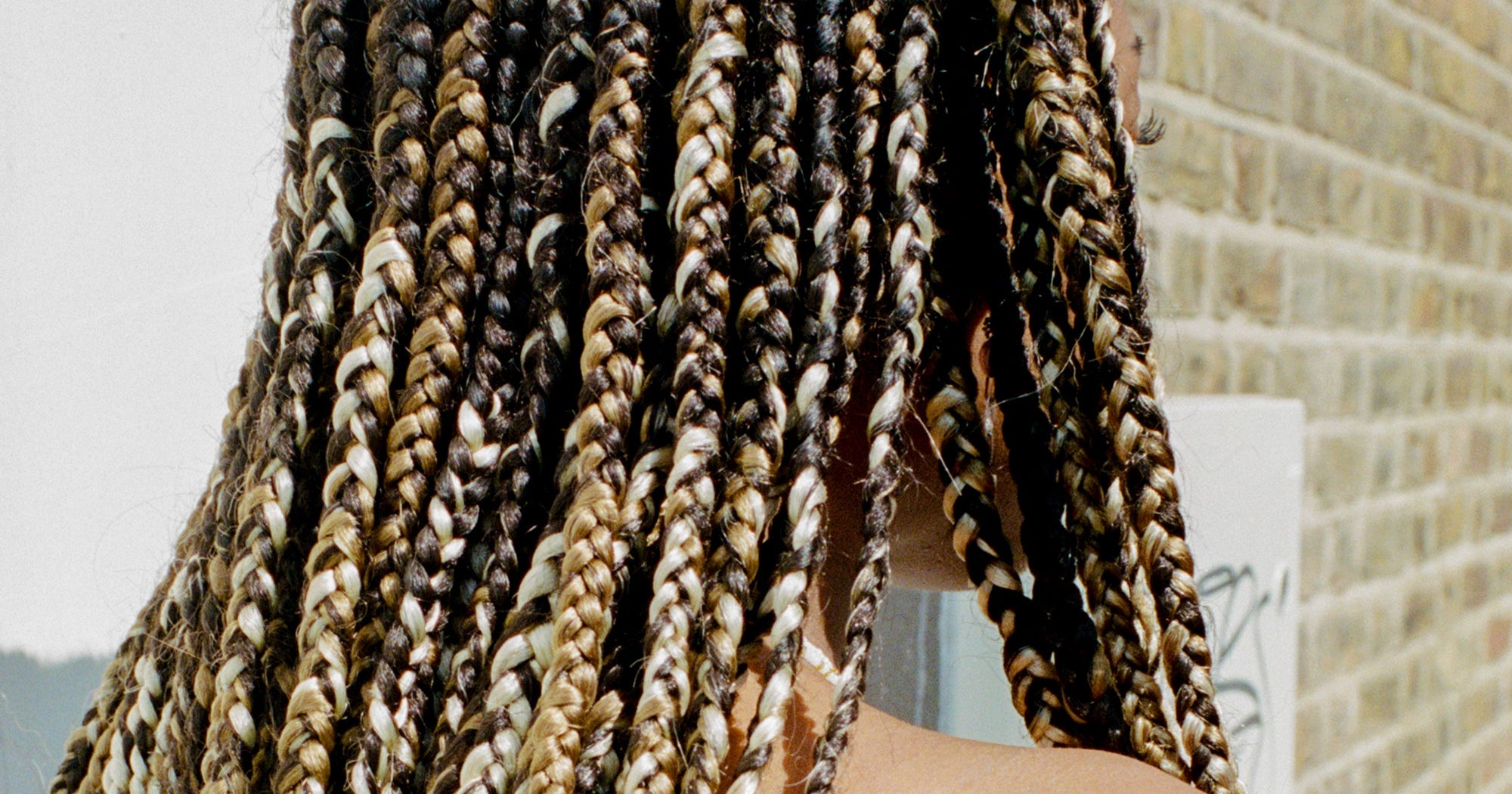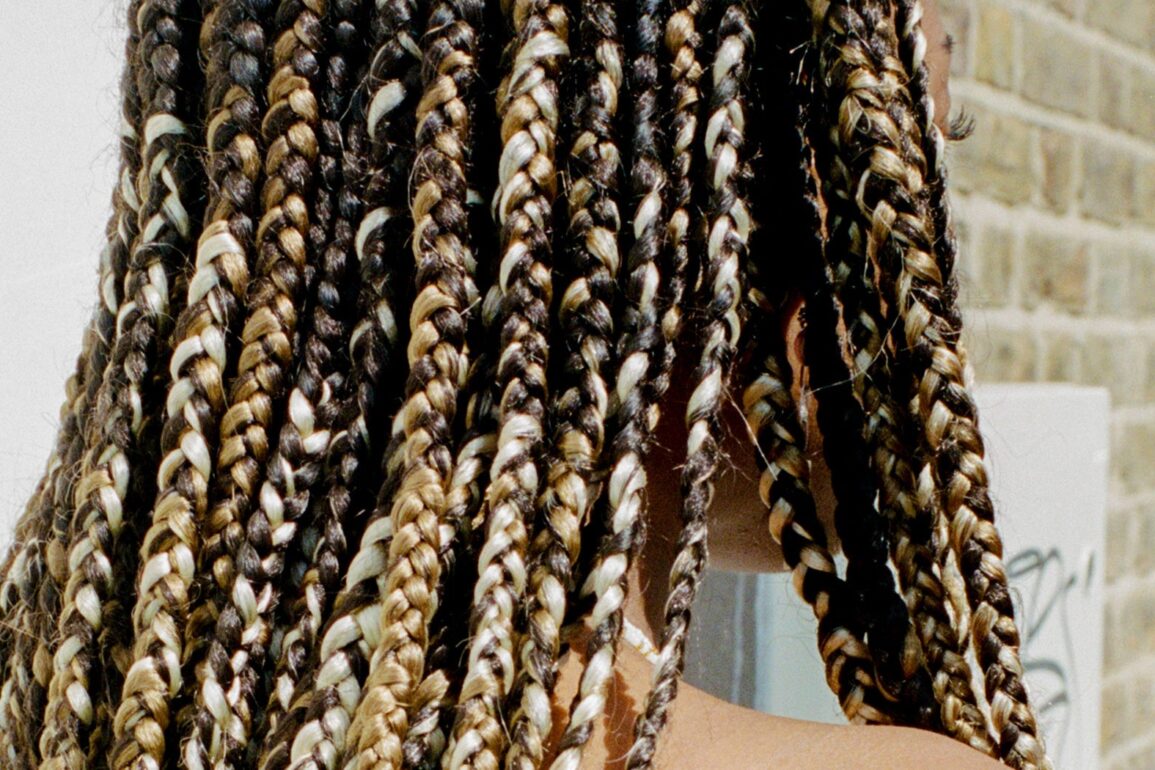
“Who’s ready to admit that braids are not a ‘protective’ hairstyle?” asked TikTok creator @kennedyandkeyonce in June. “All the pulling and tension, tugging… I got butt length braids. The weight of the additional hair on my head is creating a lot of tension on my scalp. Not even including the tension that I felt when I was actually getting my hair braided,” she said in a video that now has over 130k views. “I had to ask [the braider] multiple times if she could lighten up.”
Kennedy is one of many Black women to have experienced damage to their natural hair from wearing so-called protective hairstyles such as box braids, especially after enduring painful installations. Veronica, 29, has suffered from traction alopecia since having braids done when she was 13. “The hairdresser gripped my hair too tight, leaving permanent loss,” she tells Unbothered. “After almost 15 years, [my hair has] only started recovering with minoxidil — I had to go to a trichologist [to seek help].” Veronica now feels limited in the styles she can wear that cover the damaged area and mostly resorts to wearing wigs, which she describes as “less enjoyable” in the summer months. She is able to wear (loose) braids again but only every few years.
Hair stories like these are common. Traction alopecia as a result of tight hairstyles that pull on the hair follicle affects a third of Black women. However, there’s a fear of demonizing hairstyles that are considered traditional markers of Black ingenuity in the hair space. Are we ready to admit that protective hairstyles aren’t always protective?
What exactly makes a hairstyle “protective”?
Hairstyles such as box braids, cornrows, and weaves have long played an essential role in Black haircare and styling. These techniques are widely understood to minimize the likelihood of damage and breakage from the over-manipulation of our hair when leaving it “out”. However, these particular styles have only been referred to as “protective” in more recent years. As many of us know, hair is a huge part of Black culture and a symbol of creative expression, freedom, and identity. Various braiding and styling techniques can be traced back thousands of years and remain popular today. From Bantu knots (the small buns created by twisting hair in on itself, said to have originated with the Zulu tribes) to braids (once used to identify someone’s wealth, age, religion, and even marital status), these styles aren’t just about the protection of natural hair.
It was at the height of the natural hair movement, popularised in part by YouTube and creators such as Naptural85 and Curly Proverbz during the early 2000s, that “protective style” became a catch-all term for any hairstyle that kept our hair away for an extended period of time. YouTube became an amazing resource for sharing Black hair and beauty tips and today there are countless videos by creators detailing how protective hairstyles “grew” their hair or allowed them to retain length.
But the reality is that any style that requires a lot of manipulation or pulls excessively on the root of the hair can cause damage — sometimes long-lasting, irreversible damage from traction alopecia.
For 26-year-old Sade, the idea of “protective styling” is a newer phenomenon. “When I was younger, my hair was always in cornrows or extensions but my mum never referred to my hair as being in a protective style. It was just seen as a different hairstyle.”
“I think this overemphasis [on] protective styles means we put a lot of onus on these hairstyles to protect our hair when often the [synthetic] hair we’re putting in is full of chemicals and can cause traction [alopecia].”
@kennedyandkeyonce Probably never getting braids again honestly..#blackhair #blackhairtiktok #braids #knotless ♬ original sound – Kennedy
Your protective hairstyle shouldn’t hurt
Tatenda, 27, decided to get faux locs back in August 2023. The hairstyle, which blends hair extensions with your natural hair to create imitation locs, left her with a bald patch due to traction. “The way that they explained the style to me was that my natural hair would be plaited, then they would weave in the faux loc itself,” she tells Unbothered. “But instead they did a method where they twisted my hair almost into a loc.” Tatenda says that the style was very stiff and tight and she struggled to sleep as a result. “I had to take painkillers for the next three days.”
Tatenda told her hairdresser during the appointment that she was in pain. “If we can’t do it this way then the style can’t be done,” the hairdresser responded. Tatenda had decided to have the faux locs installed in time for her holiday but once she got there she found the style “unbearable”. “It was a hot country and all I wanted to do was have my hair up. But if I tied it up for too long, I’d get a headache,” she explains.
Frustratingly, Tatenda’s hair was also damaged after getting the popular style knotless braids. She paid £200 for the style; had it been cheaper, she says she probably would have removed the extensions sooner. It’s no surprise that with the increased cost of living and Black hair products being more expensive than products aimed at straight hair, many Black women are worried about affording hair services. “If I don’t keep a style in for long enough, I feel like I’ve wasted money,” says Tatenda. Now, she typically sticks to styles like wigs and has her hair (which she describes as fine) gently cornrowed underneath by her mum.
Like Tatenda, Sade has also experienced hair breakage in the past and says it has been tough to accept the damage, especially coming from a family full of women with “beautiful loc’d hair”. Though Sade admits that she fell into the trap of prioritizing how her hair looks over the health of the hair, she still has a big appreciation for protective hairstyles. “I change my hair and put it into these styles as a means of self-expression mostly and because it’s easier than having to do my hair every day.”
“I really enjoy being able to change my look after a six-hour turnaround,” she adds. “I’m quite expressive in my appearance and I really don’t like to follow the status quo — I feel like these styles enable me to tap into that.”
Acknowledging that protective hairstyles aren’t always protective is part of the battle against hair loss and damage. But accepting that braids, cornrows and weaves remain a key element of our self-expression is another. We’re not giving up these styles any time soon so how can we wear them with as little damage as possible?
What do Black trichologists really think about protective hairstyles?
Ebuni Ajiduah, trichologist and owner of London-based salon and trichology centre Untype, says “no style is inherently protective”.
“It all depends on the prep for the style, the person that’s doing it and how the style will work for you. Lots of styles fail at the first hurdle,” she tells Unbothered. “You could have a really good wash day routine, including deep conditioning, and then blow-dry your hair on the highest heat setting and not detangle it properly.” Ebuni explains that using high heat and not detangling your hair properly leads to damage before the style is even installed.
Ebuni likes to ask people what they are trying to protect their hair from and what their goal is.
“Is it that you have a busy work life and just don’t have time to style your hair very often? Is it that you have a very active lifestyle so you want your hair to be tucked away?”
How can we enjoy protective hairstyles without the risk of damage?
Prep your hair properly
Ebuni recommends keeping it simple: shampooing the hair to cleanse it of any product buildup, conditioning, detangling and if it’s going to be away for a little while, trimming to keep the ends healthy.
Avoid wearing a style for longer than 6-8 weeks
“While having these styles in, people typically don’t do regular maintenance of washing their hair. So by that point, I want you to make sure that you are taking care of your own hair,” says Ebuni.
Health over length
“If your goal is longer hair, the first thing we need to do is make sure your [hair] health is in order,” she says. “Do we have any deficiencies we need to treat and monitor?” Ebuni explains that for length retention, technique is important: “How gentle are you when you’re washing your hair? Are you getting regular trims? Do your styles hurt?”
Take the focus away from having “neat” hair
“The focus on neatness can hold people back,” Ebuni says. “We can be very judgmental of ourselves and others.” She explains that if our hair starts to look “messy” (frizzy at the root), we might be tempted to make it look “neater” with gel products. But use too much gel and it can sit on top of the hair and cause damage.
The pressure to have “neat” hair at all times is deeply rooted in the Black community, thanks to years of discrimination based on hair texture (a 2023 CROWN workplace research study in the US found that discrimination based on hair is still a widespread issue for Black women in the workplace, while the same study from 2019 found that Black women are more likely to be judged harshly for their looks compared to other women). But by allowing our hair the freedom to do its thing — in or out of braids — and not repeatedly taming it with heavy-duty styling products is one way to ensure a protective style does more good than harm.
Ultimately a hairstyle can be as “protective” as you’d like it to be, depending on how much or how little damage is caused in the process of having the style done and wearing the style. The key is finding the balance between wearing styles that you love and styles that maintain the health of your hair.
This post was originally published on this site be sure to check out more of their content.









